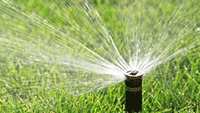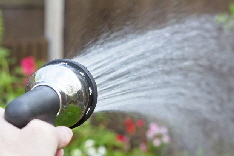Water Efficiency in the Garden


Although all waterwise plants require little water once they are well-acclimated to your garden, all require regular water to become established and unthirsty. It takes an entire year for a plant to become fully established and waterwise. At planting time, create a dirt “well†about 3- to 4-inches deep around each plant to hold sufficient water to penetrate the entire root ball. Water regularly.
The very best planting times in California are late fall (after temperatures have cooled) and early spring before the weather heats up. You can plant at any time of the year, but during the hottest months, you may need to give plants daily attention so they don’t dry out.
In general, waterwise plants are not heavy feeders, and a yearly application of fertilizer is sufficient. Waterwise plants, by their nature do not require heavy pruning. With the exception of formal hedges and the removal of spent flowers on perennials, you will only need occasional light pruning to keep plants well-shaped.
Here are ten simple things you can do to save water outdoors.
1. Water early in the morning
Set your automatic sprinklers to run in the early morning and finish before 8am. This will reduce evaporation and will lessen the likelihood of water waste from interference from winds. You’ll also find that plant disease and water damage are reduced.
2. Mulch
Placing a layer of organic mulch on the soil surface around plants can save hundreds of gallons of water each year. Mulch prevents water evaporation and also stops weeds from growing.
Learn more, and get tips about Mulching >
3. Repair and adjust sprinklers
Observe your sprinklers as they run. Adjust them as necessary to reduce overspray on sidewalks, roads, and patios etc. Repair damaged sprinklers immediately. Check pipes for leaks. Quick repairs and adjustments can save as much as 500 gallons each year.
4. Water deeper, but less often
Most gardens on automatic sprinkling systems in California are overwatered. If yours goes on every day, that’s most certainly the case. Change your system to water every other day or every third day. At the same time, increase the times by only 50-75%. You’ll have less evaporation and water will be further down where roots can continue to access the water.
5. Change watering times with the seasons
Make sure your gardener adjusts your automatic system at least three times a year. Your highest frequency will be July-October. Lowest will be November-March, with April-June somewhere in between. During periods of rain, turn automatic systems off.
6. Use trigger sprayers when hand-watering
Every hose should be equipped with a trigger sprayer so water is not wasted as you water containers and the rest of your garden. Trigger sprayers are especially useful when washing cars. Also, use a broom instead of a hose to clean driveways and sidewalks.
7. Minimize water loss in pots
Use water-retentive Danish Potting Soil in containers for all plants needing regular or ample water. For plants requiring moderate to low water, use Edna’s Best Potting soil along with Soil Moist in containers. Soil Moist is a polymer which stores water for plants’ use as the soil dries.
8. Add lots of compost to your soil
Adding store-bought or homemade compost to all your planting beds and pots will decrease the amount water needed. Clay soils that are amended with organic matter will accept and retain water better. Sandy soils improved with compost will have improved water absorption and retention.
9. Use organic fertilizers
Organic fertilizers slowly release nutrients into the soil at a natural rate that matches plants’ needs. With a slow, even feeding there is no overabundance of soft green growth that chemical fertilizers produce. Thus, your plants need less water when fed organically.
10. Install a smart sprinkler controller
The latest technology can help reduce your water use (and your water bill) dramatically. These wireless “smart controllers†activate your automatic sprinklers via computer based on current weather data and information about the specifics of your garden. You simply replace your automatic timer with a “smart controllerâ€. You will also enter easy-to-determine information about your plants and soil. You can save 40 gallons or more each day using this type of controller.
